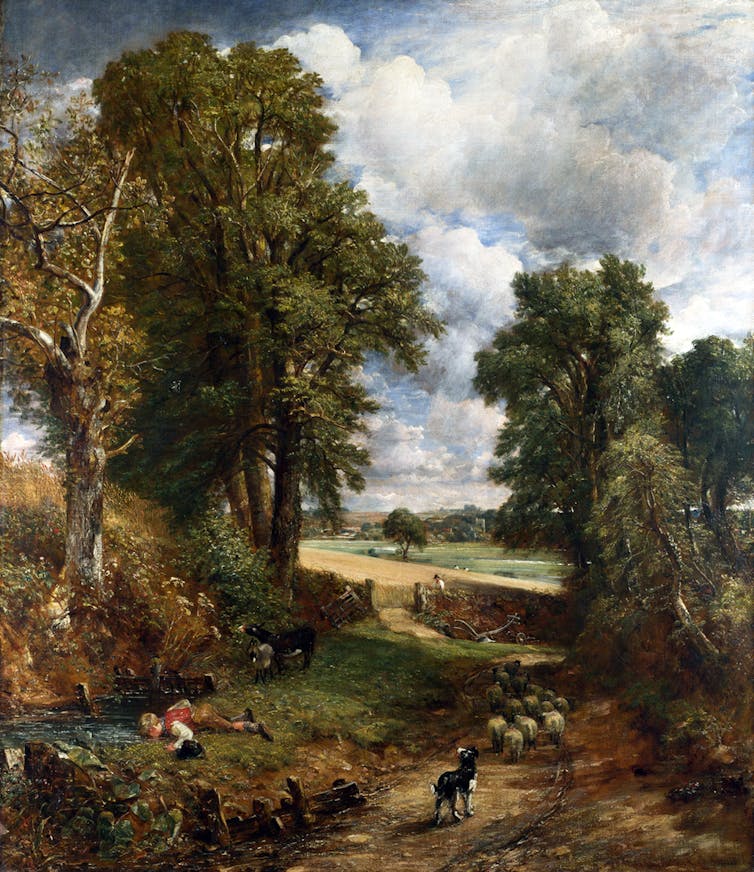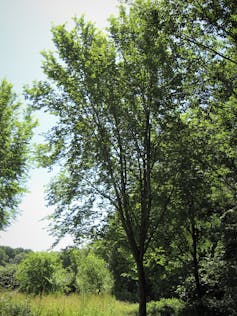
Elm trees were once stalwarts of the UK countryside that towered out of hedgerows, lined fields and woodlands. Glance at the landscape paintings of John Constable for a vague idea of what has been lost. Elm timber made ships, chairs and even water pipes until the 19th century.
These trees, and the world they held up, came crashing down when Dutch elm disease caused what is arguably the worst change to the UK’s countryside in living memory. The fungal disease carried by the elm bark beetle arrived on UK shores early in the 20th century and killed some elms but left the majority standing. Elm trees were not out of the woods though – a more virulent strain arrived in the 1960s and destroyed most of the UK’s 30 million elms.
Since the near total loss of elm save for a handful of trees that avoided the disease, generations have grown up without seeing a mature elm in the landscape. This has entrenched the public perception of elm as a lost species.

While I grew up in the countryside surrounded by trees I had always believed that the elms were gone. It was another fungal infection, ash dieback, responsible for wiping out the majority of Europe’s ash trees, that sparked my interest in tree disease. As I began a PhD researching how society responds to the loss of a tree species I started thinking about elms more. All of a sudden, I was noticing elms hiding in hedgerows.

It is the characteristic asymmetry of elm leaves, one side joining the stem further down than the other side, that gives this species away. It turns out that millions of elms still exist across the UK, particularly in southern England, as small hedgerow shrubs. In fact, these stunted relics are, according to one government plant pathologist, more numerous than the pre-epidemic elm population.
Elms have persisted by producing suckers: new stems that the trees send out from their roots. The tree may succumb to disease and die but new stems appear and take its place. These suckers allow the tree to regenerate until they are caught by the disease again, allowing elm to exist today in a cycle of life and death or what a former ecologist described to me as a perpetual adolescence.

While these “adolescent” elms demonstrate an amazing ability to persist, work is underway to restore elms to the landscape in their majestic adult form.
A new breed
Since the outbreak of the mild strain of Dutch elm disease, there have been various attempts globally to produce resistant elm.
Breeding programmes in the US, the Netherlands, Italy and Spain have yielded several varieties that can withstand even the more virulent form of Dutch elm disease. These are the result of one of two methods: hybridising European elms with naturally resistant Asian species such as Siberian elm or Himalayan elm, or finding and cloning naturally resistant European elm trees.
UK government funding for elm research has favoured efforts to understand the pathogen and how it spreads at the expense of breeding resistant varieties and trialling the suitability of elms grown outside of the UK’s climate. Fortunately, a network of knowledgeable private citizens has taken up the mantle of elm research and poured time and effort into the trees.

At sites across the UK, elm enthusiasts import and care for new varieties of disease-resistant elm. These citizen scientists monitor their suitability for the local environment, how the new trees compare with elms of the past and their ability to attract and host species traditionally associated with elms, such as the white-letter hairstreak butterfly.
A few disease-resistant elm varieties can now be bought in the UK and many have since been planted in parks and on streets. But their wider introduction is hampered by their cost. While most large-scale planting projects will buy trees for less than a pound a sapling, disease-resistant elms are only available as larger trees and come with a larger price tag; in some cases, there are additional costs for navigating post-Brexit import laws.
Lost and found
Breeders alone retain the right to propagate and sell their creations. This means that UK nurseries cannot take cuttings and start selling their own trees. One enthusiast, Dr David Herling, tried to avoid this problem by creating his own disease-resistant variety of elm that was patent-free and so unable to be sold for profit. Sadly, Herling died before he was able to see his creation reach its potential, but others continue his work to produce the tree at scale – and it is starting to gain the attention of the media.

A recent Guardian article highlighted Herling’s work and discussed new elm varieties as part of a reintroduction, a species which “disappeared” that we should “bring back”. This narrative can be seen elsewhere, in campaigns to “re-elm the British countryside”, reinforcing the false perception of elm as a lost tree and erasing the fact that millions have endured.
Elm has had a turbulent history, but there are reasons to be hopeful. This is not only because of the work of dedicated people, but because there are other ways that the species has persisted despite the departure of the towering trees of the past.
Next time you go for a walk, keep an eye out for these “missing” trees.

Don’t have time to read about climate change as much as you’d like?
Get a weekly roundup in your inbox instead. Every Wednesday, The Conversation’s environment editor writes Imagine, a short email that goes a little deeper into just one climate issue. Join the 30,000+ readers who’ve subscribed so far.
James Weldon receives funding from the Economic and Social Research Council (ESRC).
This article was originally published on The Conversation. Read the original article.







